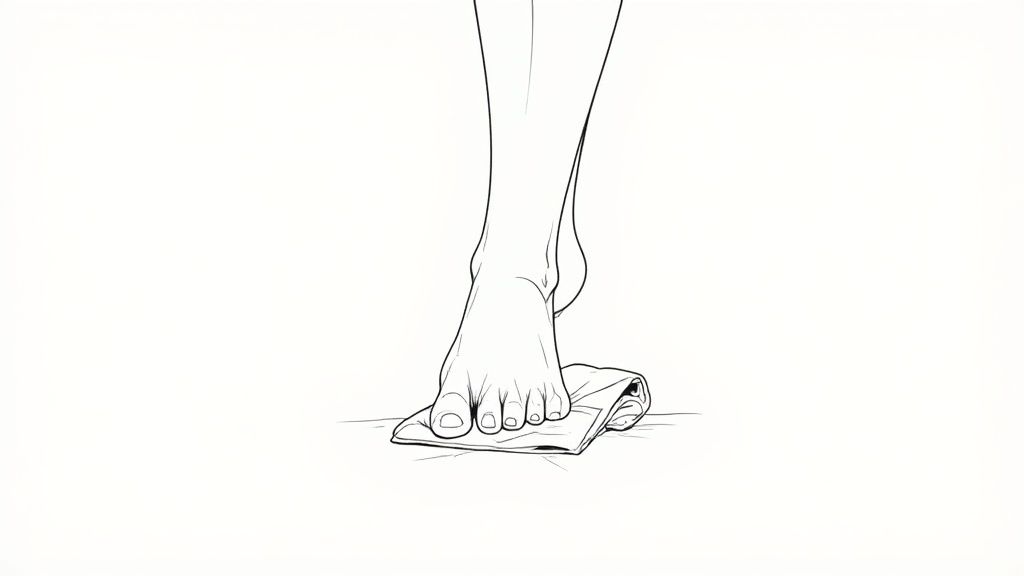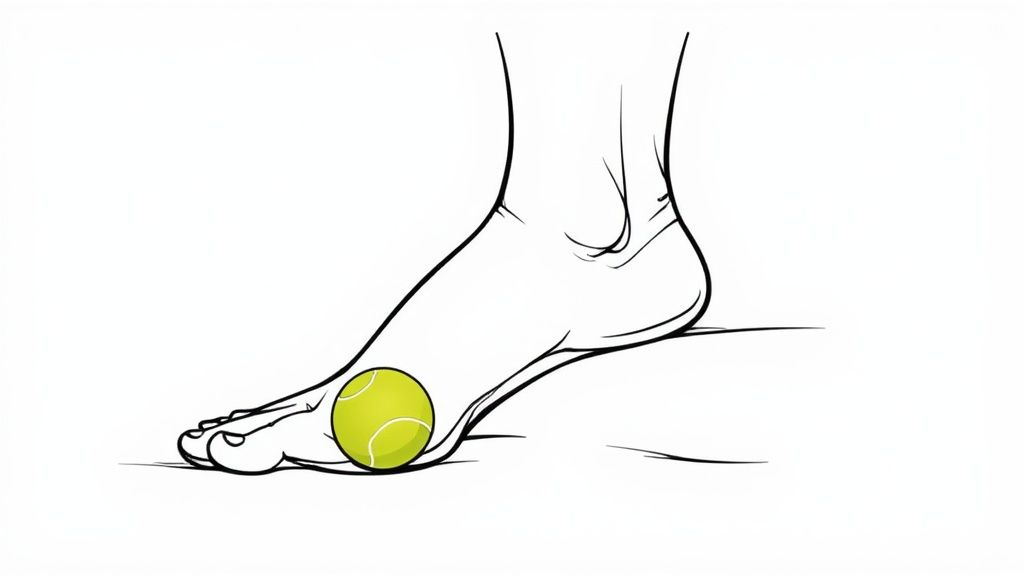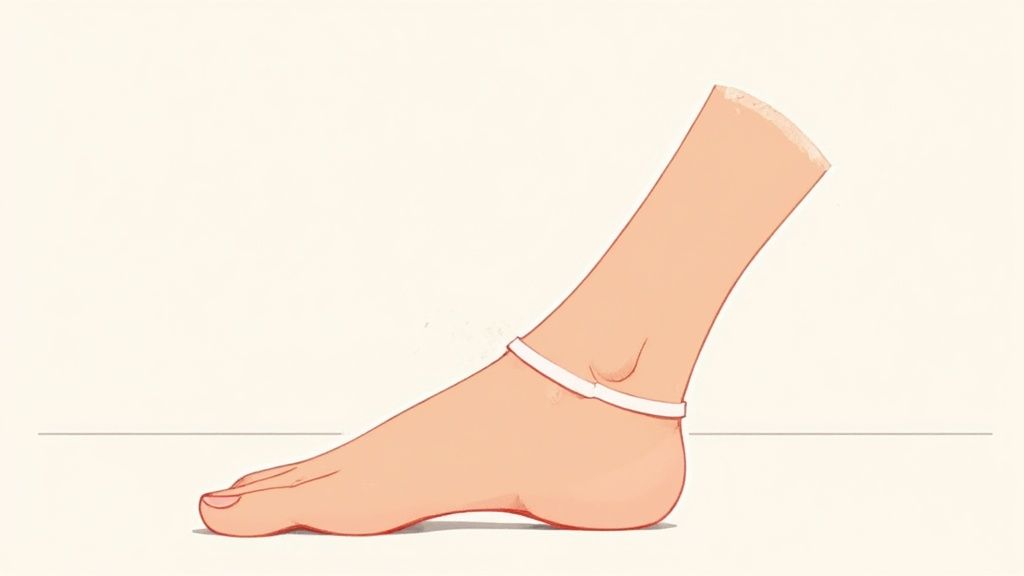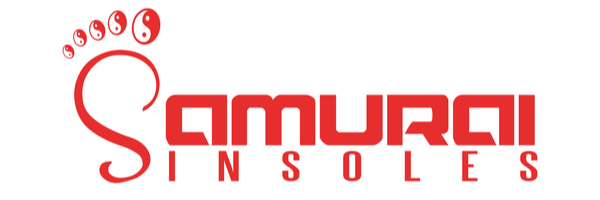Foot pain can stop you in your tracks, turning everyday activities into a challenge. Whether it's the sharp, stabbing sensation of plantar fasciitis first thing in the morning or the dull ache from overpronation after a long day, the discomfort is more than just an inconvenience. It is a barrier to living your life fully.
The good news is that relief doesn't always require expensive treatments or complex procedures. The solution can often be found in a series of targeted, simple movements designed to stretch, strengthen, and support the intricate structures of your feet. This guide provides a direct path to reclaiming your comfort and mobility.
We will walk you through eight of the most effective foot pain relief exercises, offering clear, step-by-step instructions. You will learn how each movement specifically addresses common ailments like plantar fasciitis and overpronation. We'll also show you how to enhance these benefits by pairing them with supportive solutions like Samurai Insoles, creating a comprehensive plan to put the spring back in your step. Your journey to pain-free movement starts right here.
1. Calf Stretch (Standing and Seated Variations)
Often overlooked, the muscles in your calves play a critical role in the health and function of your feet. The two primary calf muscles, the gastrocnemius and soleus, connect directly to your heel bone via the Achilles tendon. When these muscles are tight, they pull on the tendon, creating a chain reaction of tension that travels down into the plantar fascia, leading to significant heel pain and discomfort. This is why a consistent calf stretching routine is one of the most effective foot pain relief exercises you can do.

By lengthening these calf muscles, you directly reduce the strain on your Achilles tendon and, by extension, your plantar fascia. This simple action can provide profound relief, especially for those suffering from plantar fasciitis and overpronation, where excess tension is a common problem.
How to Perform the Stretches
You can effectively target both calf muscles with two simple variations. Perform these stretches daily, especially in the morning before your first steps and again before bed.
Standing Wall Stretch (for Gastrocnemius):
- Stand facing a wall, about arm's length away.
- Step one foot back, keeping the leg straight and the heel flat on the floor.
- Place your hands on the wall for support and lean forward until you feel a gentle stretch in the calf of your back leg.
- Hold this position for 30-60 seconds. Repeat 2-3 times, then switch legs.
Bent-Knee Wall Stretch (for Soleus):
- From the same starting position, slightly bend the knee of your back leg.
- Keep your heel on the ground as you lean into the wall. You should feel this stretch lower down in the calf.
- Hold for 30-60 seconds and repeat 2-3 times before switching.
Pro Tip: For a deeper seated stretch, especially if you have limited mobility, sit on the floor with your legs out straight. Loop a towel or strap around the ball of one foot and gently pull it toward you, keeping your leg straight.
Maximize Your Relief
Combining these stretches with supportive insoles creates a powerful, dual-action approach to foot health. While stretching increases flexibility and reduces muscle tension, Samurai Insoles provide the necessary arch support to correct biomechanical issues like overpronation. This ensures your foot is properly aligned during the day, preventing the calf muscles from becoming overworked and tight in the first place. Use the stretches to relieve existing tension and the insoles to prevent it from returning.
2. Towel Toe Curls and Grabs
Strengthening the small, intrinsic muscles within your feet is fundamental to building a stable and supportive foundation. Towel toe curls and grabs are simple yet highly effective resistance exercises that specifically target these muscles. By using your toes to scrunch and pull a towel, you actively engage the muscles that support your arches, which is crucial for combating issues like fallen arches and overpronation. This exercise is one of the most frequently recommended foot pain relief exercises by podiatrists for its ability to rebuild foot strength from the ground up.

When the intrinsic muscles are weak, the arch can collapse, placing immense strain on the plantar fascia. Strengthening these muscles helps to lift and support the arch naturally, improving foot mechanics and reducing the stress that leads to pain. Athletic trainers and physical therapists frequently incorporate towel grabs into rehabilitation programs to restore proper foot function and prevent future injuries.
How to Perform the Exercise
This exercise can be done while seated, making it easy to incorporate into your daily routine, like while watching TV or working at a desk. For maximum muscle activation, perform it barefoot on a smooth surface.
Towel Curls:
- Sit in a chair with your feet flat on the floor. Place a small hand towel on the floor in front of you.
- Keeping your heel on the ground, use only your toes to grasp and scrunch the towel, pulling it toward you.
- Focus on using the full range of motion in your toes, curling them to grip and pull.
- Once you've pulled the entire towel toward you, push it back out and repeat. Aim for 3-5 repetitions.
Pro Tip: To increase the difficulty and build more strength over time, place a small weight, like a can of soup or a book, on the far end of the towel. This adds resistance and challenges your muscles even further.
Maximize Your Relief
While towel curls build internal muscle strength, they are most effective when paired with external support that maintains proper foot alignment throughout the day. After strengthening your arch-supporting muscles, slipping into shoes with Samurai Insoles provides the structural reinforcement needed to prevent your arch from collapsing under the day's load. This combination approach works synergistically: the exercises build your foot’s natural support system, while the insoles provide immediate alignment and relief, ensuring the muscles you're strengthening aren't constantly being re-strained by poor biomechanics.
3. Tennis Ball Foot Roll (Self-Myofascial Release)
One of the most direct and effective foot pain relief exercises involves a simple tennis ball. This technique, known as self-myofascial release, acts as a targeted deep-tissue massage for the bottom of your foot. It works by applying focused pressure to the plantar fascia, the thick band of tissue connecting your heel to your toes. This pressure helps to break up painful adhesions and muscle knots, increase blood flow to the area, and release built-up tension, providing almost immediate relief from the sharp pain associated with plantar fasciitis.

The beauty of this exercise is its simplicity and accessibility. It's a technique taught by physical therapists for home care and used by professional athletes to keep their feet in top condition. By regularly massaging the tissues, you improve their flexibility and resilience, making your feet less susceptible to the strain caused by conditions like overpronation.
How to Perform the Exercise
You can do this exercise while sitting at a desk, watching TV, or as part of your morning routine. Consistency is key to long-term relief.
- Sit comfortably in a chair with your feet flat on the floor.
- Place a tennis ball (or a similar-sized ball) under the arch of one foot.
- Gently roll the ball back and forth, from the ball of your foot to your heel.
- Apply as much pressure as you can comfortably tolerate. When you find a particularly tender spot, pause and hold the pressure for 15-30 seconds, breathing deeply.
- Continue for 1-2 minutes, then switch to the other foot.
Pro Tip: For an added anti-inflammatory benefit, use a frozen water bottle instead of a tennis ball. The cold therapy helps reduce swelling and numb the pain while you massage the fascia. While the tennis ball foot roll is a great start, you can explore other effective strategies for getting rid of muscle knots to enhance your relief.
Maximize Your Relief
The tennis ball roll provides on-the-spot relief, but combining it with proper daily support addresses the root cause of the pain. After releasing tension with the ball, stepping into a pair of Samurai Insoles helps maintain a healthy foot posture. The insoles prevent the arch from collapsing (overpronation), which reduces the daily strain that creates knots and tension in the first place. Use the ball to manage flare-ups and the insoles to prevent them from occurring. To find more ways to soothe your feet after a long day, learn how to relieve tired feet with these proven methods.
4. Plantar Fascia Stretch
The plantar fascia is the star of the show when it comes to heel pain, and this stretch targets it directly. This thick, ligament-like band runs along the bottom of your foot, connecting your heel bone to your toes. When it becomes inflamed due to stress and tension, a condition known as plantar fasciitis, every step can be excruciating. The plantar fascia stretch is one of the most direct and powerful foot pain relief exercises because it specifically elongates this tissue, reducing strain and promoting healing.

This simple, targeted movement is a cornerstone of conservative treatment for plantar fasciitis. In fact, the American Academy of Orthopaedic Surgeons recommends it as a first-line therapy. Its effectiveness is well-documented, with many podiatry clinics reporting significant improvement in patients who perform it consistently.
How to Perform the Stretch
The best time to do this stretch is first thing in the morning, before you even get out of bed, to prepare the fascia for the day's first steps.
Seated Plantar Fascia Stretch:
- Sit on a chair or on the edge of your bed. Cross the affected foot over your opposite knee.
- Gently grasp your toes and pull them back toward your shin until you feel a distinct stretch along the arch of your foot.
- Hold this position for 10-15 seconds. You should feel the tension in the bottom of your foot, not just your toes.
- Release and repeat 10 times for each foot. Perform this routine at least twice a day.
Pro Tip: If you have trouble reaching your toes, loop a towel or a resistance band around the ball of your foot. Sit with your leg straight out in front of you and gently pull the towel toward your body to achieve the same effective stretch.
Maximize Your Relief
This stretch provides immediate, targeted relief, but its effects are amplified when paired with consistent support. While stretching lengthens a tight and painful plantar fascia, Samurai Insoles work to prevent the microscopic tears and strain that caused the problem. The insoles' built-in arch support corrects overpronation and properly distributes pressure across your foot, preventing the fascia from becoming overworked. Use this stretch to manage pain and improve flexibility, and rely on the insoles during your daily activities to provide the structural support needed for long-term healing and prevention.
5. Toe Yoga and Toe Spreading Exercises
Years of wearing constrictive shoes can cause the small, intricate muscles in your toes to weaken and become dormant. This leads to poor toe alignment, reduced balance, and increased strain on the plantar fascia. Toe yoga and spreading exercises are designed to reawaken these muscles, improve dexterity, and restore the natural splay of your toes, which is crucial for a healthy and stable foot foundation.
Activating these small muscles helps distribute weight more evenly across the entire foot, taking pressure off the heel and arch. For those with plantar fasciitis or bunions, these simple movements are powerful foot pain relief exercises that can significantly improve biomechanics and alleviate discomfort by strengthening the foot's structural support from the ground up.
How to Perform the Exercises
Integrate these exercises into your daily routine, perhaps while watching TV or sitting at your desk. Consistency is more important than intensity, so focus on controlled, precise movements.
Toe Splay and Spread:
- Sit comfortably with your feet flat on the floor.
- Without lifting your foot, try to spread your toes as far apart as possible.
- Hold the spread for 5-10 seconds, then relax.
- Repeat this 10-15 times on each foot. If this is difficult, you can use your fingers to gently assist in spreading them initially.
Big Toe Lifts (Toe Yoga):
- Keeping your four smaller toes pressed firmly to the ground, lift only your big toe.
- Hold for 5 seconds, then lower it with control.
- Next, press your big toe down and try to lift only your four smaller toes.
- Hold for 5 seconds and repeat the entire sequence 5-10 times.
Pro Tip: For a passive but effective stretch, use gel toe separators for 15-30 minutes a day. They do the work for you, gently encouraging proper toe alignment and relieving pressure from crowded toes and bunions.
Maximize Your Relief
Toe exercises strengthen your feet from within, while supportive insoles provide essential external support. This combination creates a robust system for foot health. After performing your toe yoga, sliding your feet into shoes with Samurai Insoles reinforces the benefits. The insoles' built-in arch support corrects overpronation and ensures your newly strengthened toes can function optimally, preventing the foot from collapsing inward and undoing your hard work. This synergy of strengthening and supporting is key to long-term pain relief.
6. Heel Raises and Calf Strengthening
While stretching is crucial for flexibility, strengthening the muscles that support your foot's arch and ankle is equally important. Heel raises directly target the calf muscles (gastrocnemius and soleus), the Achilles tendon, and the small intrinsic muscles within your feet. This targeted strengthening enhances your foot's ability to absorb shock during activities like walking and running, which is a key component of any effective foot pain relief exercises program.
Stronger calf and foot muscles provide better support for the plantar fascia, preventing it from overstretching and becoming inflamed. For individuals with overpronation, building this muscular endurance helps control the inward rolling of the foot, addressing one of the root causes of pain. This exercise is foundational in physical therapy for everything from ankle sprain recovery to improving functional mobility in older adults.
How to Perform the Exercise
Start with the basic double-leg version and progress as you get stronger. Aim to perform these exercises daily or every other day, depending on your comfort level.
Double-Leg Heel Raise:
- Stand with your feet flat on the floor, about hip-width apart. You can hold onto a wall or chair for balance if needed.
- Slowly rise up onto the balls of your feet, lifting your heels as high as you comfortably can. Squeeze your calf muscles at the top.
- Hold this top position for 2-3 seconds to maximize muscle engagement.
- Slowly lower your heels back to the floor with control. Start with 2 sets of 10-15 repetitions.
Progression to Single-Leg:
- Once the double-leg version feels easy, progress to a single-leg heel raise.
- Stand on one leg, lifting the other foot off the ground.
- Perform the same controlled movement of rising onto the ball of your foot and slowly lowering back down.
- Complete 10-15 repetitions before switching legs.
Pro Tip: To increase the range of motion and get a better stretch at the bottom, perform your heel raises on the edge of a stair or step. Let your heels drop slightly below the level of the step before rising up.
Maximize Your Relief
Strengthening exercises like heel raises build the muscular "scaffolding" your feet need, while supportive insoles provide the structural foundation. This combination is incredibly effective. By performing heel raises, you are training your muscles to better support your arch. When you then wear Samurai Insoles, you give those muscles the external support they need to function correctly throughout the day without fatiguing. This synergy allows the muscles to grow stronger during exercise and remain protected during daily activities, preventing the recurrence of strain and pain.
7. Arch Strengthening Exercises (Short Foot Exercise)
While stretching addresses muscle tightness, directly strengthening the foot's internal support system is essential for long-term stability. The "short foot" exercise is a powerful technique designed to activate and build the intrinsic muscles that form your medial longitudinal arch. By strengthening these muscles, you create a natural, dynamic support structure that helps absorb shock and maintain proper foot alignment, reducing the strain on the plantar fascia. This makes it one of the most foundational foot pain relief exercises for tackling the root cause of overpronation and arch collapse.
This exercise effectively teaches your foot how to support itself. For individuals with flat feet or overpronation, where the arch tends to collapse inward, building this internal strength is a game-changer. It helps counteract the biomechanical flaws that lead to chronic foot pain, heel pain, and plantar fasciitis.
How to Perform the Exercise
The goal is to lift your arch without curling your toes. This isolates the small, deep muscles responsible for arch support.
Short Foot Exercise (Seated to Standing):
- Sit in a chair with your feet flat on the floor, toes pointing straight ahead.
- Without curling or extending your toes, try to draw the ball of your foot back toward your heel. Imagine you are trying to make your foot shorter and lift the arch up.
- Your toes and heel should remain on the floor, relaxed.
- Hold the contraction for 5-10 seconds, feeling the muscles in your arch engage.
- Relax, then repeat for 10-15 repetitions. Perform this 2-3 times daily.
Pro Tip: Once you master the seated version, progress to performing it while standing, and eventually on one leg for an advanced challenge. This progression builds functional strength that supports you during daily activities like walking and standing.
Maximize Your Relief
Combining arch strengthening with external support offers comprehensive protection. The short foot exercise builds your foot's internal muscular support, while Samurai Insoles provide consistent, reliable external support throughout the day. This dual approach ensures your arch is supported from both inside and out. Use the exercises to actively build a stronger foundation, and rely on the insoles to maintain proper alignment and prevent your arches from collapsing under the strain of daily life. This combination helps prevent fatigue and reinforces the benefits of your strengthening routine.
8. Ankle Alphabet and Range of Motion Exercises
Ankle stiffness and limited mobility are often overlooked contributors to foot pain, including plantar fasciitis. When the ankle joint can't move through its full, natural range of motion, other parts of the foot and lower leg must compensate. This compensation creates abnormal stress patterns on the plantar fascia and surrounding muscles, leading to strain and inflammation. The Ankle Alphabet is a simple yet powerful mobility exercise designed to combat this stiffness.
This dynamic stretch gently moves your ankle and foot through every plane of motion, improving joint lubrication, increasing circulation, and reducing the rigidity that contributes to pain. By encouraging fluid movement, you are essentially re-educating the joint to function correctly, making it one of the most comprehensive foot pain relief exercises for addressing overall foot and ankle health. This is particularly beneficial for office workers who sit for long periods or anyone experiencing morning stiffness.
How to Perform the Exercise
The beauty of this exercise lies in its simplicity. You can do it anywhere, anytime, without any equipment. It’s an excellent routine to perform at your desk, while watching TV, or as a gentle warm-up before other stretches.
- Sit comfortably in a chair with your feet flat on the floor.
- Lift one foot off the ground, extending your leg slightly so your foot can move freely.
- Keeping your leg still, use your big toe as a "pen" to slowly and deliberately trace each letter of the alphabet in the air.
- Focus on making the letters as large and complete as possible to maximize the range of motion.
- Once you've completed the entire alphabet from A to Z, repeat with the other foot.
Pro Tip: For an added challenge and to build stability, perform this exercise while standing and balancing on one leg. In addition to improving range of motion, incorporating Yoga Balance Exercises can significantly enhance the stability of your feet and ankles.
Maximize Your Relief
Consistent mobility work is key, but it works best when paired with continuous support. After improving your ankle’s range of motion with the Ankle Alphabet, Samurai Insoles help maintain proper foot alignment throughout the day. The insoles' built-in arch support prevents the foot from collapsing inward (overpronation), which is a primary cause of ankle strain and instability. This combination ensures that the newfound flexibility from your exercises is protected, preventing your joints from stiffening up again under the stress of daily activities. For those needing extra support during more intense activities, understanding options like ankle taping vs. bracing can also be beneficial.
Foot Pain Relief Exercises Comparison
| Exercise | Implementation Complexity 🔄 | Resource Requirements ⚡ | Expected Outcomes 📊 | Ideal Use Cases 💡 | Key Advantages ⭐ |
|---|---|---|---|---|---|
| Calf Stretch (Standing & Seated) | Low - simple movements, easy to learn | None for basic, just space | Improved calf/Achilles flexibility, reduced heel pain | Plantar fasciitis, Achilles tightness | Immediate relief, versatile variations |
| Towel Toe Curls and Grabs | Moderate - requires coordination | Bath towel, optional weights | Stronger intrinsic foot muscles, improved toe dexterity | Fallen arches, foot stability | Builds foot strength, progressive difficulty |
| Tennis Ball Foot Roll | Low - easy self-massage technique | Tennis ball (inexpensive) | Pain relief, improved tissue mobility | Plantar fasciitis, foot tension relief | Portable, immediate pain relief |
| Plantar Fascia Stretch | Low - simple stretch | None or towel/strap for assistance | Direct plantar fascia elongation, pain reduction | Plantar fasciitis, morning pain | Highly specific, evidence-based |
| Toe Yoga and Toe Spreading | Moderate - requires patience | None (optional toe spacers) | Improved toe mobility, balance, and toe alignment | Toe deformities, footwear-related issues | Enhances foot function, prevents deformities |
| Heel Raises and Calf Strengthening | Moderate - requires balance and control | None (optional weights/platforms) | Increased calf & Achilles strength, ankle stability | Achilles tendinopathy, ankle instability | Functional strength, easy progression |
| Arch Strengthening (Short Foot) | Moderate - needs instruction | None | Stronger medial arch, improved foot posture | Flat feet, arch collapse | Active arch support, foot stability |
| Ankle Alphabet & ROM Exercises | Low - simple to perform | None | Increased ankle flexibility, circulation | Stiffness, post-injury mobility | Comprehensive mobility, easy recall |
Integrating Your New Routine for Lasting Relief
You now have a powerful toolkit of eight distinct foot pain relief exercises designed to restore flexibility, build strength, and put you back in control of your foot health. From the deep release of the Tennis Ball Foot Roll to the foundational strength of the Short Foot Exercise, each movement targets a crucial component of your foot’s complex structure. The journey from chronic discomfort to lasting relief, however, is built not just on performing these exercises, but on integrating them into a consistent, supportive daily routine.
Think of it as a two-part strategy. Your internal work consists of diligently practicing these stretches and strengthening movements. Your external support comes from creating an environment where your feet can thrive, which is where your footwear and insoles become critical allies.
Building Consistency: Your Path to Success
Consistency is the single most important factor in achieving meaningful results. Sporadic efforts will only provide temporary relief, but a dedicated daily or weekly practice will fundamentally retrain your muscles and ligaments.
- Start Small and Build Momentum: Don't overwhelm yourself. Begin by choosing just two or three exercises, like the Calf Stretch and Towel Toe Curls, and commit to doing them every day. Once that becomes a habit, gradually add more movements from the list.
- Link it to an Existing Habit: The easiest way to form a new habit is to attach it to one you already have. For example, perform your foot exercises right after you brush your teeth in the morning or while you watch your favorite evening show.
- Listen to Your Body: Pay close attention to what your feet are telling you. If you feel sharp pain, ease back. The goal is a gentle stretch and muscle activation, not strain.
Key Takeaway: The power of these foot pain relief exercises is unlocked through repetition. A few focused minutes each day is far more effective than one long, infrequent session.
The Synergy of Exercise and Support
Mastering these exercises is the first step. The second, equally important step is ensuring your feet are properly supported throughout the day, especially when you are standing, walking, or running. This is where the synergy between active exercise and passive support comes into play.
The exercises you've learned work to correct issues like overpronation and weak arches from the inside out. However, every step you take in unsupportive shoes can counteract that progress. Samurai Insoles are designed to bridge this gap. They provide the essential external framework that holds your foot in its optimal alignment, reducing the daily strain on your plantar fascia and arch.
When you perform the Arch Strengthening exercises and then slide your foot into a shoe equipped with a Samurai Insole, you are reinforcing that correct posture. This combination accelerates your recovery, prevents re-injury, and transforms your footwear into an active part of your relief strategy, ensuring the benefits of your hard work last all day long.
Ready to give your feet the 24/7 support they deserve? Complement your new exercise routine with the biomechanically-engineered support of Samurai Insoles. Explore our collection today at Samurai Insoles and discover how the right insole can amplify the results of your foot pain relief exercises.



